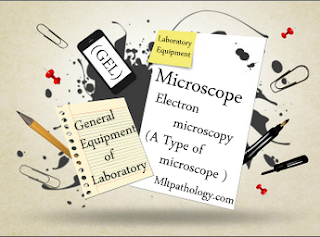Electron Microscopy
The maximum resolution obtained with a microscope that uses light waves (wavelength approximately 300 to 700 nm) to illuminate the object is limited to 0.2 microns or 200 nm. Therefore, most viruses and other very fine structures cannot be seen with any light microscope. However, if a beam of electrons, having a wavelength of 0.05 nm is used, the resolution can increase dramatically by about 2000 times (0.1 nm).
The maximum resolution obtained with a microscope that uses light waves (wavelength approximately 300 to 700 nm) to illuminate the object is limited to 0.2 microns or 200 nm. Therefore, most viruses and other very fine structures cannot be seen with any light microscope. However, if a beam of electrons, having a wavelength of 0.05 nm is used, the resolution can increase dramatically by about 2000 times (0.1 nm).
Working principle of an electron
microscope The
convergence of a light beam by a convex lens has its counterparts in the
convergence of an electron beam as it passes through the core of a circular
magnetic field. Most electron microscopes use electromagnetic lenses. The
conveyance of an electron beam produces an image. The image and object
distances are related to the focal length of the lens in exactly the same way
as in light optics. The electron microscope is therefore constructed on the
same optical principles as the light microscope and the same formulae can be
used to correlate magnification and focal distances.
The electron
beam is obtained from a heated tungsten filament which is surrounded by a metal
may be substituted by a photographic plate to make a permanent record.
The entire
illuminating imaging system is usually referred to as the microscope column and
is constructed upside down compared to light microscope. The electron and the
condenser are placed above and the image formed below. The column is very
rigidly constructed and is maintained in high vacuum since air molecules would
deflect the electron beam.
The specimen is introduced into the object plane through an air lock. Therefore, it is not possible to examine living material in the electron microscope.
The specimen is introduced into the object plane through an air lock. Therefore, it is not possible to examine living material in the electron microscope.
Electron
optics are essentially similar to light optics. One important difference,
however, is that the formation of the image is due to scattering of electrons
by the molecules of the specimen.
This scattering solely depends on mass densities. Elements of high atomic weight such as lead or uranium cause marked electron scatter and appear very dense in the electron image. The lighter elements such as carbon, oxygen and nitrogen cause less electron scatter and have poor contrast. In the electron microscope, the image is due to absorption of light which depends more on molecular structure than atomic
This scattering solely depends on mass densities. Elements of high atomic weight such as lead or uranium cause marked electron scatter and appear very dense in the electron image. The lighter elements such as carbon, oxygen and nitrogen cause less electron scatter and have poor contrast. In the electron microscope, the image is due to absorption of light which depends more on molecular structure than atomic
Most
biological stains depend on the absorption of certain wavelengths of light due
to their molecular structure and are composed mainly of carbon, nitrogen and
hydrogen atoms.
Since these are all of low atomic weight they have little electron scattering power and are not generally useful as stains for electron microscopy. Unstained tissues have very poor contrast in electron microscopy. They may be stained by a variety of heavy metal salts. Most such stains' are relatively non-specific, e.g., lead citrate, lead hydroxide and uranyl acetate. The sections are supported on thin plastic grids.
Since these are all of low atomic weight they have little electron scattering power and are not generally useful as stains for electron microscopy. Unstained tissues have very poor contrast in electron microscopy. They may be stained by a variety of heavy metal salts. Most such stains' are relatively non-specific, e.g., lead citrate, lead hydroxide and uranyl acetate. The sections are supported on thin plastic grids.
A disadvantage of the electron microscopy is that it is necessary to examine the objects in vacuum because the gas molecules in the air can scatter electrons and distort the image. Therefore only dead and dried objects can be examined in the electron microscope, which may lead to considerable distortion in the object. There are several techniques available for this microscope, including staining methods with heavy metals and radioactive substances. The method used depends on the type of electron microscope and the purpose of the examination.
In
transmission electron microscopy, heavy metals can be used as stains, making
some parts of the cell appear dark beacause electrons cannot penetrate them.
With the
scanning electron microscopy (Fig. 3.28b), a three-dimensional view of the
object can be obtained. The object is coated with a thin film of metal. The beam
of electrons moves back and forth over the surface of the object to produce a
pattern which depicts the structure of the object. This pattern can be detected
by a device similar to a television camera.










If you have any queries related medical laboratory science & you are looking for any topic which you have have not found here.. you can comment below... and feedback us if you like over work & Theory
.
Thanks for coming here..